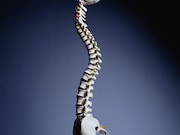Those at high risk for fracture who plan prolonged PrEP use may wish to consider alternative strategies
THURSDAY, July 25, 2019 (HealthDay News) — Tenofovir preexposure prophylaxis (PrEP) therapy does not appear to be associated with clinically significant declines in bone mineral density (BMD) in the short term, according to a study published online June 19 in AIDS Research and Human Retroviruses.
In a substudy of a large PrEP demonstration project, Matthew A. Spinelli, M.D., from the University of California in San Francisco, and colleagues examined data gathered over a median of 24 weeks from 254 highly adherent individuals who were on PrEP for the first time (June 2011 to December 2013). BMD was measured using dual-energy X-ray absorptiometry. Tenofovir exposure was estimated from tenofovir-diphosphate levels in dried blood spots.
The researchers found that the percent decline in spine BMD was monotonically associated with increasing average weekly adherence. Trends using hip BMD measurements were not significant. For individuals with estimated daily adherence, there was a 1.2 percent decrease in spine BMD and a 0.5 percent decline in hip BMD. This was a lower-than-expected drop in BMD for highly adherent PrEP users, compared with that seen in previous studies.
“This drop is likely not clinically significant for most PrEP users,” the authors write. “However, for those at the highest risk of fracture who plan prolonged PrEP use, alternate PrEP strategies could be considered.”
Copyright © 2019 HealthDay. All rights reserved.








